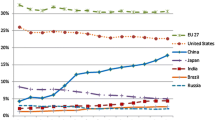Abstract
Witnessing a substantial growth rate in its scientific production, Iran is considered as one of the recently rising stars in scientific contribution scene. However, its impact in science progress is widely unknown, especially at global level. Studying Iran’s scholarly publications and recognition in SCI, the present communication tries to clarify the country’s science system performance using regression analyses and then to compare its performance to that of the world, using Relative Citation Rate (RCR) and Relative Subfield Citedness (RW). The results of the regression analyses reveal that although Iran displays considerable weaknesses in its performance, it is increasingly recognized as its outputs grow. According to the RCR values, Iran performed at/above the global level in 21 subfields. However, the RW values show that the country’s performance is above the global level in only two subfields. Although Iran is very far from an ideal situation; these evidences can be considered as heralds of a successful movement towards a wealthy scientific future.



Similar content being viewed by others
Notes
As the JCR provides no data at subfield level for year 2002, immediacy indexes of the related journals were used to calculate the citations from 2002 to papers published in year 2002. The numbers of citations to these papers in each year from 2003–2007 were extracted from JCR 2003–2007.
References
Bhattacharjee, Y. (2004). Scientific Publishing: Suit seeks to ease trade embargo rules. Science, 306(5693), 30.
Brumfiel, G. (2004). Publishers split over response to US trade embargo ruling. Nature, 24, 663.
Davari Ardakani, R. (2007, August 12). The illusion of development by increasing the amount of papers in ISI. Iran [in Persian]. Retrieved July 26, 2008, from http://www.iraninstitute.com/1386/860521/html/think.htm.
Gaffney, O. (2003). IEEE under fire for withdrawing Iranian members’ benefits. Science, 301(5640), 1646.
Glänzel, W., Schubert, A., & Czerwon, H.-J. (1999). A bibliometric analysis of international scientific cooperation of The European Union (1985–1995). Scientometrics, 45(2), 185–202.
Hayati, Z., & Ebrahimi, S. (2008). Correlation between quality and quantity in scientific production: A case study of Iranian organizations from 1997 to 2006. Scientometrics, 80(3). doi:10.1007/s11192-009-2094-3.
Jokar, A., & Ebrahimi, S. (2007). Nations tendency towards citing Iranian scientific outputs. Majjale-ye Ketabdari va Ettela’ Resani (The journal of library and information Science; in Persian), 10 (4), Retrieved July 8, 2008, from http://www.aqlibrary.ir./Issue/ShowOneArticle.aspx?Articlecode=478.
Katz, J. S. (1999a). The self similar science system. Research Policy, 28, 501–517. Retrieved July 3, 2004, from http://www.sussex.ac.uk/spru/jskatz.
Katz, J. S. (1999b). Bibliometric indicators and the social sciences, prepared for the ESRC. Retrieved July 3, 2004, from http://www.sussex.ac.uk/spru/jskatz.
Katz, J. S. (2000). Scale-independent indicators and research evaluation. Science and Public Policy, 24(1), 23–36. Retrieved July 3, 2004, from http://www.sussex.ac.uk/spru/jskatz.
Katz, J. S., & Hicks, D. (1995, June 7–10). The classification of interdisciplinary journals: A new approach. In: Proceeding of the fifth biennial conference of the international society for scientometrics and informatics, Rosary College, River Forest, IL, USA. Retrieved September 5, 2004, from http://www.sussex.ac.uk/Users/sylvank/pubs/ClassInterdiscJournals.pdf.
Khosrokhavar, F. (2004). Report on science in post-revolutionary Iran—Part I, emergence of a scientific community? Critical Middle Eastern Studies, 13, 209–224.
Kingman, S. (2004). Scientific publishers divided over US trade embargo ruling. Bulletin of the World Health Organization, 82(4), 312.
Koenig, R. (2000). Iranian science: Iran’s scientists cautiously reach out to the world. Science, 290(5496), 1484–1487.
Mehrdad, M., Heydari, A., Sarbolouki, M. N., & Etemad, S. (2004). The basic science in Islamic Republic of Iran. Scientometrics, 61(1), 79–88.
Moin, M., Mahmoudi, M., & Rezaei, N. (2005). Scientific output of Iran at the threshold of the 21st century. Scientometrics, 62(2), 239–248.
Moosavi, F. (2003). The study of the possibility of ascending of Iran to top ten science producing countries of the world. Rahyaft [in Persian], 30, 79–89.
Norouzi, A. (2007, September 18). The latest reports of ESI on Iran’s scientific productivity and ranking. Retrieved July 25, 2008, from http://www5.irandoc.ac.ir/irandoc/news.aspx?id=267.
Osareh, F., & Wilson, C. S. (2000). A comparison of Iranian scientific publications in the Science Citation Index: 1985–1989 and 1990–1994. Scientometrics, 48(3), 427–442.
Osareh, F., & Wilson, C. S. (2002). Collaboration in Iranian scientific publications. Libri, 52, 88–98.
Rahni, D. N. (2003). Economic sanctions go too far. Chemical & Engineering News, 81(50), 2.
Schubert, A., & Braun, T. (1986). Relative indicators and relational charts for comparative assessment of publication output and citation impact. Scientometrics, 9, 281–291.
Schubert, A. Glänzel, W., & Braun, T. (1983). Relative citation rate: A new indicator for measuring the impact of publication. In D. Tomov & L. Dimitrova (Eds.), Proceedings of the first national conference with international participation on scientometrics and linguistics of scientific text (pp. 80–81), Varna.
Science Watch. (2003). Middle Eastern Nations making their mark. Retrieved August 5, 2004, from http://www.sciencewatch.com/nov-dec2003/sw_nov-dec2003_page1.htm.
Sotudeh, H., Changiz, F., & Hashemnia N. (2008, March 5–6). Iranian scientists’ approach to publishing in and referencing to Open Access journals. In Presented at the first conference on medical scientometrics, Isfahan Medical University, Isfahan, Iran.
Vinkler, P. (1986). Evaluation of some methods for the relative assessment of scientific publications. Scientometrics, 10, 157–177.
Vinkler, P. (2002). Subfield problems in applying the Garfield (impact) factors in practice. Scientometrics, 53, 237–279.
Yalpani, M., & Heydari, A (2006). A critical study of research status in Iran: the case of scientific profiles of 10 highly productive Iranian chemists. Korsi News 2006 [in Persian] Retrieved July 26, 2008, from http://www.korsi.ir/Statics/DR.%20HEIDARI%20ARTICLE.doc.
Yalpani, M., Heydari, A., & Mehrdad, M. (2005). Application of scientometric methods to chemical research in Iran: Reflections on Iran’s current science policy. Scientometrics, 63(3), 531–547.
Author information
Authors and Affiliations
Corresponding author
Rights and permissions
About this article
Cite this article
Sotudeh, H. Are Iranian scientists recognized as their productivity enhances? A comparison of Iran’s impact to global norms in different subfields of Science Citation Index during 2002–2005. Scientometrics 83, 39–54 (2010). https://doi.org/10.1007/s11192-009-0018-x
Received:
Accepted:
Published:
Issue Date:
DOI: https://doi.org/10.1007/s11192-009-0018-x




